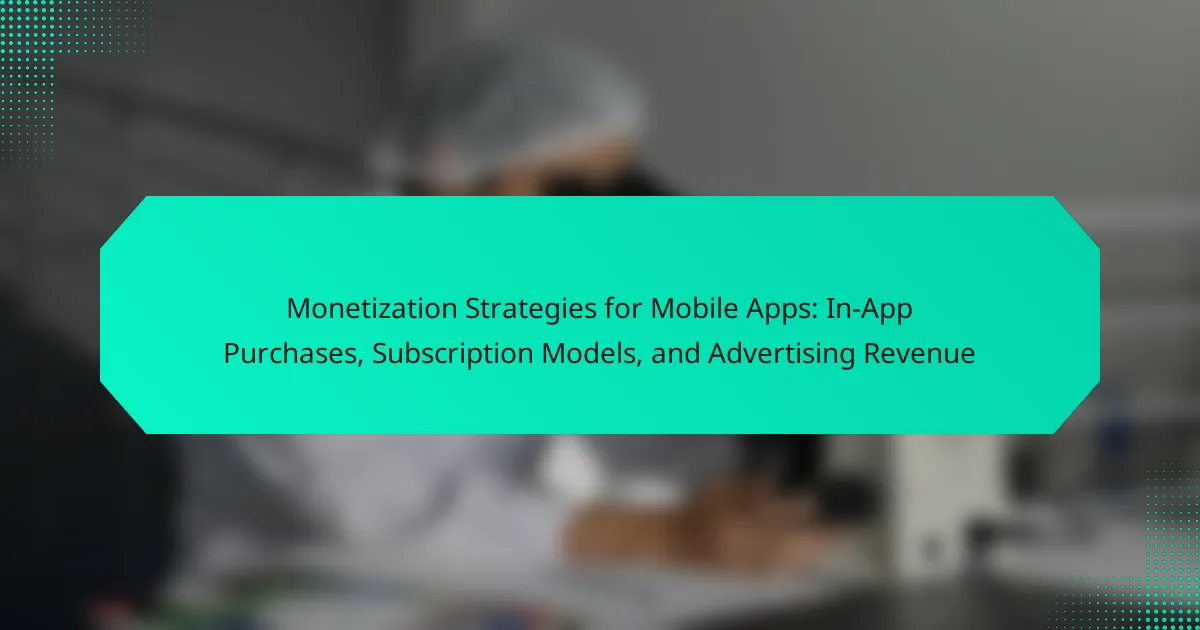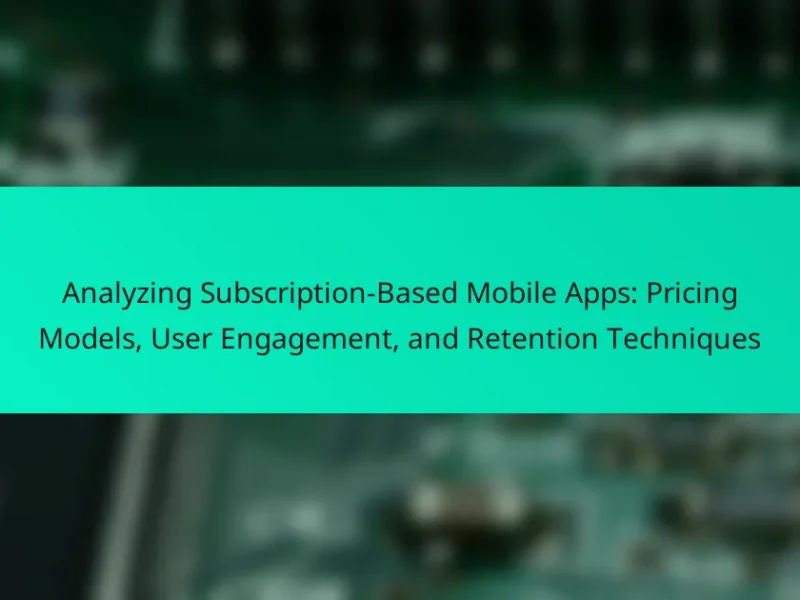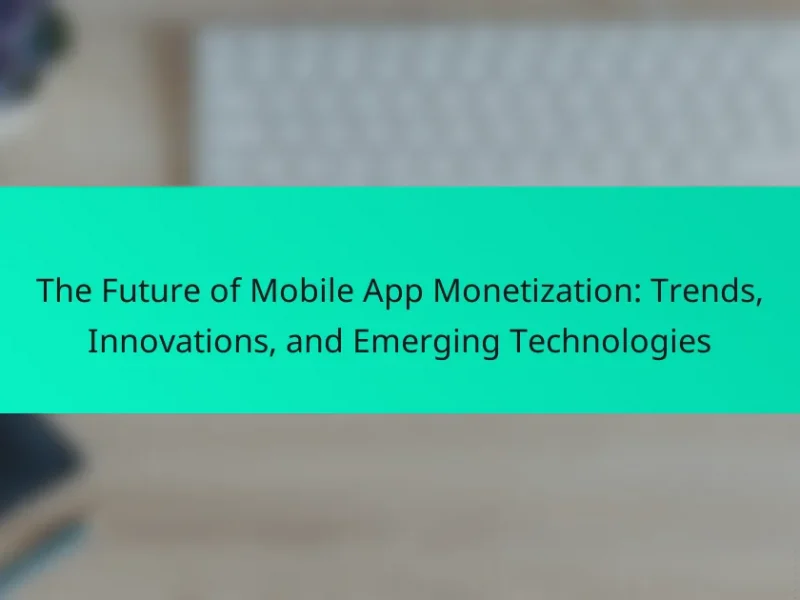Monetization strategies for mobile apps encompass in-app purchases, subscription models, and advertising revenue. In-app purchases enable users to acquire virtual goods or premium features, while subscription models provide a recurring revenue stream by charging users for ongoing access to content or services. Advertising revenue is generated through displaying ads, often facilitated by partnerships with ad networks. The article highlights the projected growth of these strategies, with in-app purchases expected to reach $189 billion by 2024 and mobile ad spending anticipated to surpass $290 billion. It also addresses the benefits and challenges associated with each monetization approach, emphasizing the importance of user engagement and satisfaction in maximizing revenue.
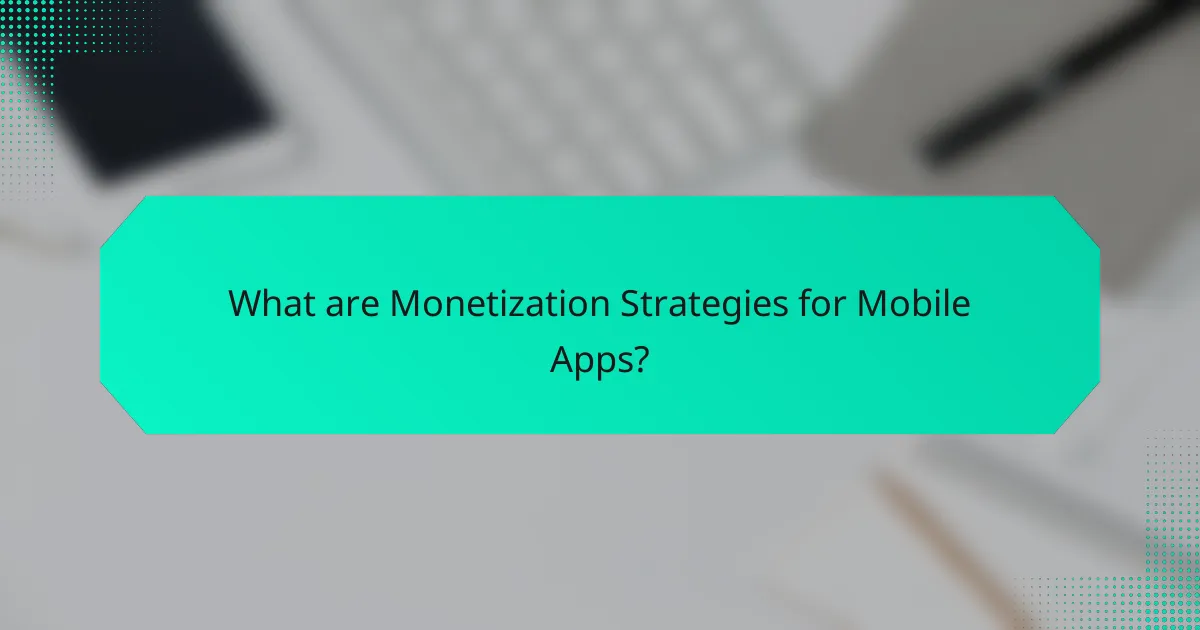
What are Monetization Strategies for Mobile Apps?
Monetization strategies for mobile apps include in-app purchases, subscription models, and advertising revenue. In-app purchases allow users to buy virtual goods or premium features within the app. Subscription models charge users a recurring fee for continued access to content or services. Advertising revenue generates income by displaying ads to users, often through partnerships with ad networks. According to Statista, mobile app revenue from in-app purchases is projected to reach $189 billion by 2024. Additionally, subscription services have shown significant growth, with the number of subscribers increasing annually. Advertising revenue remains a major income source, with mobile ad spending expected to surpass $290 billion by 2024. These strategies help developers maximize revenue while enhancing user experience.
How do different monetization strategies impact app profitability?
Different monetization strategies significantly impact app profitability. In-app purchases allow users to buy additional content or features, generating direct revenue. Subscription models provide recurring income through regular user payments, enhancing long-term profitability. Advertising revenue depends on user engagement and impressions, translating to income from advertisers. A study by Statista shows that apps with in-app purchases can generate up to 50% more revenue than those relying solely on ads. Furthermore, subscription-based apps have seen a 25% increase in user retention compared to one-time purchase models. Each strategy’s effectiveness varies based on target audience and app type, influencing overall financial success.
What factors influence the choice of monetization strategy?
The choice of monetization strategy is influenced by several key factors. These factors include target audience, app type, and market competition. Understanding the target audience helps in selecting a strategy that aligns with user preferences. For instance, casual gamers may prefer in-app purchases, while subscription models may appeal to users seeking ongoing content. The app type also plays a significant role. Games often utilize different strategies compared to utility apps. Market competition can determine pricing and feature offerings. Apps in saturated markets may need to differentiate their monetization approach to attract users. Additionally, the development costs and revenue goals of the app influence the chosen strategy. Balancing these factors is crucial for effective monetization.
How does user engagement affect monetization success?
User engagement significantly affects monetization success in mobile apps. Higher engagement leads to increased in-app purchases. Engaged users are more likely to subscribe to premium features. They also interact more with advertisements, generating higher ad revenue. For instance, a study by Apptopia found that apps with high user retention see a 30% increase in revenue. This correlation highlights the importance of maintaining user interest and activity. Engaged users contribute to a sustainable revenue model. Thus, enhancing user engagement is crucial for maximizing monetization success.
What are the primary types of monetization strategies?
The primary types of monetization strategies include in-app purchases, subscription models, and advertising revenue. In-app purchases allow users to buy virtual goods or features within the app. Subscription models charge users a recurring fee for access to content or services. Advertising revenue generates income by displaying ads to users within the app. These strategies are commonly used in mobile apps to maximize revenue potential. According to a report by Statista, in-app purchases accounted for over 50% of global mobile app revenue in 2021.
What are In-App Purchases and how do they work?
In-app purchases are transactions that allow users to buy virtual goods or services within a mobile application. They enable app developers to monetize their apps beyond initial download fees. In-app purchases can include items such as extra lives in games, premium content, or subscription services. Users typically make these purchases through app stores like Apple’s App Store or Google Play. Payment is processed via the user’s linked payment method. Developers receive a portion of the revenue, while the app store retains a commission. This model supports ongoing revenue generation and enhances user experience by providing additional content or features.
What is the Subscription Model and its advantages?
The subscription model is a business strategy where customers pay a recurring fee for ongoing access to a product or service. This model provides companies with predictable revenue streams. It allows for better customer retention due to continuous service delivery. Customers often enjoy lower upfront costs compared to one-time purchases. According to a 2021 report, subscription services have grown by 437% over the past decade. This growth indicates a strong consumer preference for subscription-based offerings. Additionally, subscriptions can enhance customer engagement through regular updates and new content. Overall, the subscription model aligns with modern consumer habits and preferences.
How does Advertising Revenue function in mobile apps?
Advertising revenue in mobile apps functions by displaying ads to users and generating income based on interactions. App developers integrate ad networks into their applications. These networks serve ads based on user demographics and app usage patterns. Revenue is typically earned through impressions, clicks, or actions taken by users. For instance, Cost Per Mille (CPM) pays developers for every thousand ad impressions. Cost Per Click (CPC) compensates for each click on an ad. Additionally, Cost Per Action (CPA) generates revenue when users complete specific actions after clicking an ad. According to eMarketer, mobile ad spending is projected to reach $200 billion by 2023, highlighting the significance of advertising revenue in app monetization.

What are the benefits and challenges of In-App Purchases?
In-app purchases provide significant revenue opportunities for mobile apps. They allow users to buy virtual goods or features directly within the app. This model can lead to higher user engagement and retention. A report by Sensor Tower indicates that in-app purchases generated over $120 billion in 2020 alone.
However, challenges exist with in-app purchases. Users may feel frustrated by aggressive monetization tactics. This can lead to negative reviews and decreased user satisfaction. Additionally, developers must navigate app store policies regarding in-app purchases. Compliance with these rules is essential for maintaining app visibility and revenue.
How can developers effectively implement In-App Purchases?
Developers can effectively implement In-App Purchases (IAP) by following several key strategies. First, they should integrate a reliable payment gateway that supports multiple payment options. This enhances user convenience and increases the likelihood of purchases. Second, developers must design a user-friendly interface that clearly displays IAP options. Clear labeling and easy navigation improve user experience.
Third, offering a mix of consumable and non-consumable items can cater to different user preferences. Consumables, like in-game currency, encourage repeat purchases. Non-consumables, such as premium features, provide lasting value. Fourth, developers should implement tiered pricing strategies. This allows users to choose from various price points, making purchases more accessible.
Fifth, developers should utilize analytics to track user behavior. Understanding how users interact with IAP options can inform future improvements. Sixth, providing incentives, such as discounts or limited-time offers, can drive urgency and boost sales. Finally, ensuring compliance with app store guidelines is crucial. Adhering to these rules prevents potential issues that could affect revenue.
What types of content or features are best suited for In-App Purchases?
In-app purchases are best suited for virtual goods, premium features, and additional content. Virtual goods include items like skins, avatars, or power-ups in games. Premium features can enhance user experience, such as ad removal or advanced functionalities. Additional content often involves new levels, chapters, or exclusive access to events. Research indicates that games generate the highest revenue from in-app purchases, with 74% of mobile revenue coming from this model. Apps offering customization options and exclusive content also see higher engagement and spending rates.
What are common pitfalls to avoid with In-App Purchases?
Common pitfalls to avoid with in-app purchases include unclear pricing and lack of transparency. Users may feel misled if prices are not clearly displayed. Another pitfall is excessive prompts for purchases, which can frustrate users. This may lead to negative reviews and decreased user retention. Failing to provide value for the purchase can also deter users. Users expect meaningful content or enhancements for their money. Additionally, not testing the purchase flow can result in technical issues. Such problems can disrupt the user experience and lead to lost sales. Lastly, neglecting to comply with app store guidelines can result in penalties. Adhering to these guidelines is essential for maintaining app visibility and credibility.
What role does user feedback play in optimizing In-App Purchases?
User feedback is crucial for optimizing In-App Purchases (IAPs). It provides insights into user preferences and behaviors. Developers can identify what features or items users value most. This feedback can highlight areas for improvement in pricing strategies. For example, if users find a particular item too expensive, adjustments can be made. Additionally, feedback can reveal usability issues in the purchasing process. Addressing these concerns can enhance the overall user experience. Research shows that apps utilizing user feedback see increased engagement and revenue from IAPs. A study by App Annie found that apps with regular updates based on user feedback can boost revenue by up to 30%.
How can user preferences shape In-App Purchase offerings?
User preferences can significantly shape In-App Purchase offerings by guiding the types of products and pricing strategies used. By analyzing user behavior and feedback, developers can identify popular features and content that users are willing to pay for. For instance, if users frequently engage with a specific game level or character, developers can create targeted offerings related to that content. Data from user interactions can inform pricing models, ensuring that offerings align with what users find valuable. Research shows that apps tailored to user preferences see a 20% increase in conversion rates for In-App Purchases. This demonstrates the direct correlation between understanding user preferences and optimizing purchase offerings.
What metrics should developers track to assess In-App Purchase performance?
Developers should track several key metrics to assess In-App Purchase (IAP) performance. These metrics include Average Revenue Per User (ARPU), which indicates the revenue generated per user. Tracking Conversion Rate is crucial, as it shows the percentage of users who make a purchase. Customer Lifetime Value (CLV) helps in understanding the total revenue expected from a user over their engagement period. Retention Rate measures how well the app keeps users returning, impacting IAPs. Additionally, Monitoring Churn Rate is vital as it indicates the percentage of users who stop using the app. Analyzing Purchase Frequency reveals how often users make purchases within the app. Finally, tracking Revenue Growth Rate shows the increase in revenue over time, providing insight into overall performance. These metrics together give a comprehensive view of IAP effectiveness and user engagement.
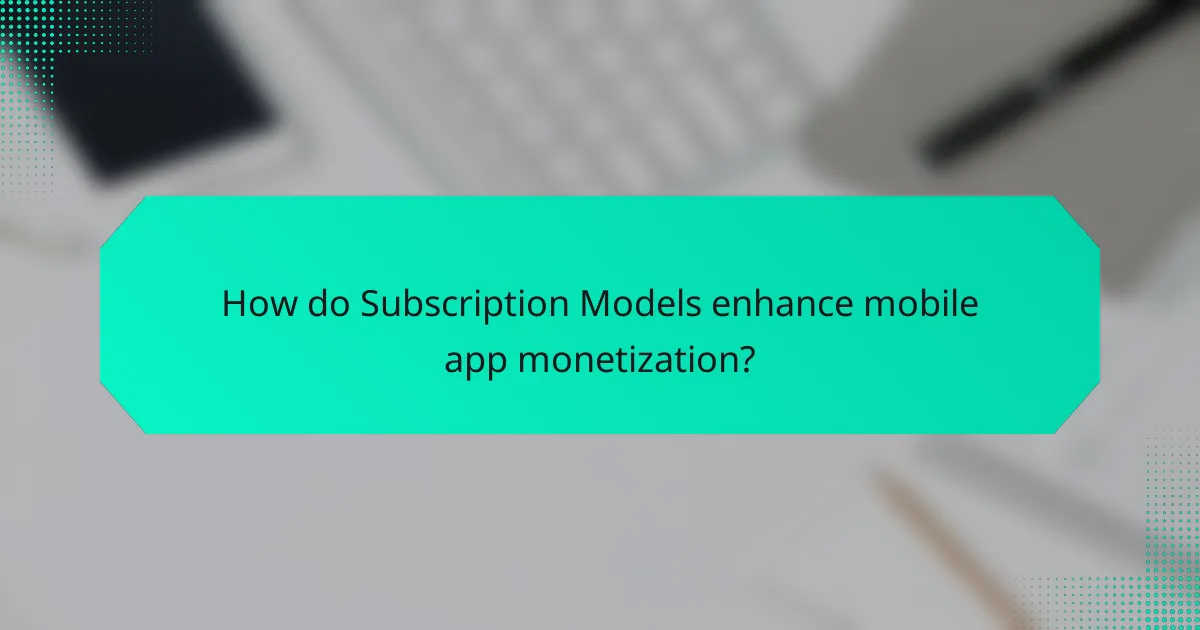
How do Subscription Models enhance mobile app monetization?
Subscription models enhance mobile app monetization by providing a steady revenue stream. They allow developers to charge users on a recurring basis, which can lead to higher lifetime value per user. This model also encourages ongoing user engagement, as users are more likely to return to apps they are subscribed to. According to a report by Statista, subscription revenue for mobile apps is expected to reach $30 billion by 2025, highlighting its growing importance. Additionally, subscription models can reduce user churn by offering exclusive content or features. This creates a sense of value that encourages users to maintain their subscriptions. Overall, subscription models align revenue generation with user satisfaction, making them a powerful monetization strategy.
What are the key elements of a successful subscription model?
A successful subscription model includes several key elements. First, it must offer clear value to the user. This value can be in the form of exclusive content, features, or services. Second, pricing should be competitive and transparent. Users need to understand what they are paying for and why it is worth it. Third, flexibility in subscription terms is essential. Options such as monthly or annual plans cater to different user preferences. Fourth, an effective onboarding process enhances user experience. This helps users understand how to maximize the benefits of the subscription. Fifth, consistent communication with subscribers builds loyalty. Regular updates and engagement keep users informed and interested. Lastly, data analytics play a crucial role. Tracking user behavior helps optimize offerings and improve retention rates. These elements collectively contribute to the effectiveness of a subscription model.
How do pricing strategies affect user retention in subscription models?
Pricing strategies significantly influence user retention in subscription models. Effective pricing can enhance perceived value. This leads to higher customer satisfaction. A study by McKinsey found that 50% of users are more likely to stay if they perceive their subscription as a good deal. Competitive pricing attracts new users while retaining existing ones. Additionally, tiered pricing models can cater to diverse user needs. This flexibility increases overall engagement. Research indicates that personalized pricing can boost retention rates by 20%. Thus, strategic pricing is essential for maintaining a loyal user base in subscription models.
What features can enhance the value of a subscription service?
Flexible payment options enhance the value of a subscription service. They allow users to choose plans that fit their budgets. Offering monthly, quarterly, and annual subscriptions caters to diverse financial preferences. Personalized content recommendations increase user engagement. Tailoring suggestions based on user behavior keeps subscribers interested. Exclusive content access is a significant value addition. It provides unique offerings that are not available to non-subscribers. High-quality customer support boosts user satisfaction. Quick and effective assistance can reduce churn rates. Family or group plans encourage shared subscriptions. This feature appeals to users looking to save costs. Regular updates and new features maintain subscriber interest over time. Keeping the service fresh and relevant is crucial for retention.
How can user acquisition strategies support subscription growth?
User acquisition strategies can significantly enhance subscription growth by expanding the user base. Effective strategies attract potential subscribers through targeted marketing campaigns. These campaigns can utilize social media, search engine optimization, and influencer partnerships.
By increasing visibility, user acquisition strategies drive more downloads and installations. A larger user base provides more opportunities for conversions to paid subscriptions. Additionally, personalized onboarding experiences can convert new users into subscribers effectively.
Data shows that apps with strong user acquisition strategies see higher subscription rates. For instance, a study by App Annie indicates that apps focusing on user acquisition experience 30% more subscription growth than those that do not.
In summary, user acquisition strategies are crucial for driving subscription growth by increasing visibility, attracting users, and optimizing conversion rates.
What marketing techniques are effective for promoting subscriptions?
Effective marketing techniques for promoting subscriptions include offering free trials. Free trials allow potential users to experience the service without commitment. This approach increases conversion rates significantly. Another technique is leveraging social proof through testimonials and case studies. Positive reviews can influence potential subscribers’ decisions. Email marketing campaigns targeting existing users can also boost subscriptions. Personalized offers based on user behavior can enhance engagement. Utilizing referral programs encourages current subscribers to bring in new users. Discounts for long-term subscriptions can incentivize users to commit. Data shows that these strategies collectively improve subscription rates and user retention.
How does trial access impact subscription conversion rates?
Trial access significantly increases subscription conversion rates. Offering a trial allows potential subscribers to experience the service without commitment. This exposure builds trust and showcases the value of the subscription. Research indicates that users who engage with a trial are 60% more likely to convert to paid subscriptions. Additionally, trials can reduce buyer hesitation by allowing users to assess the product firsthand. This strategy capitalizes on user experience to drive conversions effectively.

What are effective strategies for generating Advertising Revenue?
Effective strategies for generating advertising revenue include optimizing ad placements and formats. Mobile apps can increase revenue by utilizing banner ads, interstitial ads, and native ads. Targeting specific demographics enhances ad relevance and engagement. Implementing programmatic advertising can maximize fill rates and revenue. A/B testing different ad strategies helps identify the most profitable approach. Additionally, partnering with ad networks can provide access to a broader range of advertisers. According to eMarketer, mobile ad spending is projected to reach $290 billion by 2024, highlighting the growing potential for revenue generation in this space.
What types of advertising formats are available for mobile apps?
Mobile apps can utilize various advertising formats to generate revenue. Common formats include banner ads, which are rectangular advertisements displayed at the top or bottom of the app screen. Interstitial ads are full-screen ads that appear at transition points in the app, often between activities or levels. Rewarded video ads allow users to watch a video in exchange for in-app rewards, enhancing user engagement. Native ads blend seamlessly into the app’s content, providing a less intrusive experience. Additionally, programmatic ads use automated technology to buy and sell ad space in real-time, optimizing ad delivery. Each format serves different user experiences and monetization strategies, contributing to the overall revenue potential of mobile apps.
How do native ads differ from banner ads in terms of user experience?
Native ads integrate seamlessly into the content of a platform, enhancing user experience. They match the form and function of the surrounding content, making them less intrusive. Users often find native ads more engaging compared to traditional banner ads. Banner ads typically disrupt the browsing experience and can lead to banner blindness, where users ignore them. Research shows that native ads can increase user interaction rates by up to 53% compared to banner ads. This higher engagement translates to better brand recall and positive user sentiment. Overall, native ads provide a more cohesive and enjoyable experience for users.
What are the advantages of programmatic advertising for mobile apps?
Programmatic advertising offers several advantages for mobile apps. It enables real-time bidding, allowing advertisers to reach their target audience efficiently. This method enhances ad relevance by utilizing user data for personalized targeting. Increased automation reduces the need for manual ad placements, saving time and resources. Programmatic advertising also improves ad performance through data-driven insights and analytics. According to eMarketer, programmatic ad spending is expected to reach $98 billion by 2023, showcasing its growing importance in the advertising landscape. Additionally, it provides access to a wide range of inventory across multiple platforms, maximizing revenue opportunities for app developers.
How can developers optimize ad placements for better revenue?
Developers can optimize ad placements for better revenue by strategically positioning ads within their apps. Placing ads in high-traffic areas increases visibility and engagement. For example, ads located near content that users frequently interact with can lead to higher click-through rates.
Using A/B testing helps identify the most effective ad placements. Developers can experiment with different locations and formats to see which combinations yield the highest revenue. Additionally, analyzing user behavior can inform ad placement decisions. Understanding where users spend the most time allows developers to place ads in those areas.
Implementing frequency capping prevents ad fatigue and maintains user engagement. Limiting how often users see the same ad can enhance their experience and increase the likelihood of interaction.
Utilizing responsive ad formats ensures ads display well across different devices. This adaptability can improve user experience and increase the chances of ad engagement.
Lastly, partnering with ad networks that offer high fill rates can maximize revenue potential. A diverse range of ads can keep the content fresh and engaging for users.
What factors should be considered when choosing ad placements?
When choosing ad placements, consider audience demographics. Understanding the target audience helps in selecting relevant ad spaces. Analyze user behavior within the app. This insight can guide effective placement strategies. Evaluate the visibility of ad placements. High visibility often leads to better engagement rates. Assess the context of the content. Ads should align with the app’s purpose and user expectations. Consider the ad format and size. Different formats may perform better in specific placements. Review historical performance data. Analyzing past ad performance can inform future placement decisions. Lastly, ensure compliance with platform guidelines. Ad placements must adhere to the policies of app stores and advertising networks.
How does ad frequency affect user retention and revenue?
Ad frequency significantly impacts user retention and revenue. High ad frequency can lead to user fatigue. This fatigue often results in users abandoning the app. A study by eMarketer found that excessive ads can decrease engagement by up to 50%. Conversely, optimal ad frequency can enhance revenue without harming retention. Maintaining a balanced ad load encourages users to stay engaged. Research indicates that users prefer a moderate number of ads. This preference can lead to higher click-through rates and increased revenue.
What best practices should developers follow for successful monetization?
Developers should follow several best practices for successful monetization. First, they need to understand their target audience. This understanding helps tailor monetization strategies effectively. Second, implementing a freemium model can attract more users. This model offers basic features for free while charging for premium features. Third, regular updates and improvements keep users engaged and willing to spend. Engaged users are more likely to make in-app purchases or subscribe. Fourth, clear communication of value is essential. Users must understand the benefits of paid features. Fifth, optimizing the user experience enhances retention and monetization. A seamless, enjoyable experience encourages users to invest in the app. Lastly, analyzing user data helps refine monetization strategies. Data-driven decisions lead to better outcomes and increased revenue.
How can continuous testing improve monetization strategies?
Continuous testing enhances monetization strategies by enabling data-driven decision-making. It allows developers to assess user engagement and behavior in real-time. By analyzing user feedback, developers can refine in-app purchases and subscription models. This iterative process leads to improved user experiences and increased revenue. A study by McKinsey found that companies adopting continuous testing saw a 10-20% increase in revenue. Regular testing also identifies effective advertising placements, optimizing ad revenue. This approach ensures that monetization strategies remain aligned with user preferences and market trends.
What are common mistakes to avoid in mobile app monetization?
Common mistakes to avoid in mobile app monetization include overloading users with ads. Excessive advertising can lead to poor user experience and app abandonment. Another mistake is failing to understand the target audience. Misalignment with user preferences can reduce engagement and revenue. Implementing a one-size-fits-all pricing strategy is also detrimental. Different users may respond better to varied pricing models. Neglecting user feedback can result in missed opportunities for improvement. Listening to users can inform better monetization strategies. Additionally, ignoring app store optimization can hinder visibility. A lack of proper marketing may lead to low user acquisition. Lastly, not analyzing data regularly can prevent informed decision-making. Continuous analysis of user behavior is crucial for successful monetization.
Monetization strategies for mobile apps encompass in-app purchases, subscription models, and advertising revenue, essential for maximizing developer income and enhancing user experience. In-app purchases enable users to acquire virtual goods or premium features, while subscription models provide ongoing access to content for a recurring fee. Advertising revenue is generated through ad placements within the app, leveraging user engagement to drive income. The article explores how these strategies impact app profitability, the factors influencing their selection, and the importance of user engagement in optimizing monetization success. Additionally, it addresses best practices and common pitfalls to avoid in mobile app monetization.
